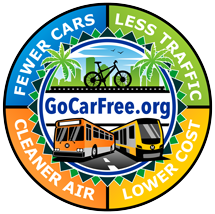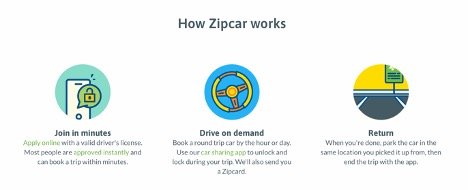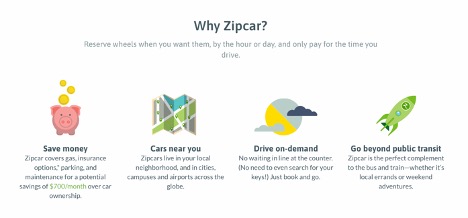
Lesson 19
Pick Me Up: The Miracle of Car Sharing and Ridesharing

My daughter with the Coco self-driving food delivery robots that are all over Santa Monica.
If you’ve learned to commute to work without a car, eliminate unnecessary trips, find closer alternatives, and make your errands come to you, you’re 99 percent of the way to living well without owning a car. But there are still some things that are best accomplished in a motor vehicle.
If you just need a ride somewhere, then ridesharing apps like Uber and Lyft are the perfect solution. I won’t spend time explaining Uber and Lyft because I think most people have at least tried them and understand the basics of how they work. If not, check out the video below which explains ridesharing 101 for first time users.
Then I’ll move on to the topic of car sharing. Car sharing is totally different from ridesharing. It’s much more versatile, it’s more of a replacement for car ownership, and it might be just what you’re looking for.
What Is Car Sharing?
Car sharing is basically very short term vehicle rental assisted by technology. This article on Ridester.com describes car share companies this way, “They differ from car rental companies, including rental alternatives like Turo, in that they charge by the hour – sometimes even by the minute or mile – so you never pay for a full day you don’t use.”
The other big difference between car sharing and rental car companies like Enterprise or Hertz is the technology. Car share vehicles have sensors and cellular antennas on board so you can use the car share app to unlock the car with your cell phone, then drive away. You never need to go to the rental car location, wait in line, or deal with a person. Very convenient.

Whether you need to haul firewood (most firewood sellers deliver, by the way) or move a couch, for some tasks it’s more convenient to use a car, truck, or minivan. In these cases, car sharing is the perfect solution. With car sharing, you get to use a car without the costs and responsibilities of owning one.
A Growing Niche in Transportation
Car-sharing companies have found a fast-growing niche. Their market is city dwellers who are tired of the expense and headache of owning a car, but still occasionally want to use one.
According to the U.S. Transportation Research Board, “Car sharing has experienced exponential growth.” Car sharing began in 1998 in three U.S. cities; there is now some form of car sharing in nearly forty U.S. cities. In 2000 there were only six car-sharing organizations in this country; there are now more than 23 in the U.S. and eleven in Canada.
Ridester.com listed the Six Best Car Sharing Services in the U.S. The list includes Zipcar, Getaround, Maven (shut down), Enterprise CarShare, Share Now, and GIG Car Share.
Boston-based Zipcar is the largest U.S. car-sharing company, with more than one million members and over 10,000 vehicles. Zipcar operates in more than 150 cities in the US and Canada, and in the United Kingdom, Turkey, Taiwan, Iceland, and Costa Rica. Zipcar also operates on hundreds of college and university campuses.

How Car Sharing Works
Car-sharing organizations keep a fleet of cars and light trucks in parking spots scattered around a city. Members make reservations by calling a toll-free number or by using a website or app – anywhere from one minute to one year in advance. Members then just walk to the car they reserved, access it with an electronic keycard, and drive away.
When they’re finished using the car, members return it to the same parking spot. Drivers don’t directly pay for gas, insurance, taxes, registration, parking, or maintenance. Instead, car-sharing members typically pay a flat hourly fee, a per-mile rate, and a membership fee.
Drivers can usually apply for a membership in a matter of minutes online. You must be twenty-one or older, have a valid driver’s license, and meet certain safe driving standards. Once approved, members have access to a fleet of vehicles ranging from economy cars and hybrids to BMWs, Mini Coopers, convertibles, and pickup trucks. All vehicles are vacuumed, washed, and serviced on a regular basis.

Car Free Success Story:
Since I take the metro to work (it’s faster door-to-door than driving, and cheaper than paying to park in the garage), I only ever need a car on evenings and weekends. When you calculate the cost of owning a car that you only use maybe once or twice a week, it just doesn’t make sense. Plus, my car got broken into, someone bumped it while it was parked, it needed new tires, and whenever I went out of town for work or vacation, I had to find someone to move it all the time. So getting rid of it felt like the sensible thing to do. And it was actually a liberating experience! Not to mention all that extra $$ in my pocket.
Then I joined Zipcar. There were Zipcars all over my neighborhood, often closer than I could even find a space for my own car, so it seemed pretty convenient. I use Zipcar mostly for those random last-minute things. The other day I had to bring a big box to the post office and it was raining. There was a Honda Element less than two blocks away, and in an hour I returned it, which cost me about half what two Uber rides would. I like picking people up at the airport and impressing them with a BMW – even three hours of Zipcar rental is cheaper than the airport shuttle. Once I forgot something at work and zipped back to the office in a Prius. (When you use a Zipcar you call it “zipping.”).
There are Zipcars near work too, so if I need to run an errand during my lunch hour, it’s no problem. I have a friend who uses Zipcar to drive back home and walk his dog during the day, which is cheaper than hiring a dog walker. It’s just so much cheaper than owning a car. When I need a car for a couple days or a week at a time, then I rent one from Avis or Hertz, and get a great deal online . . . gotta pay for gas though; that stinks.
On-Demand Transportation without the Hassle
The ease of use and booming growth of car sharing, combined with the ubiquity and convenience of ridesharing, is making car ownership unnecessary in many urban areas and university campuses. Car sharing and ridesharing transform automobiles from a product to a service. Members get all the benefits of using a car without the hassles of owning one.
Car sharing makes accessing a vehicle twenty-four hours a day as easy as withdrawing money from an ATM. And unlike renting a car, there is no time-consuming paperwork or in-person check-in process.
Many car-sharing customers say they use car sharing when they need the car for only a few hours, or when they need a car on the spur of the moment; they use a traditional rent-a-car when they need a vehicle for a few days or a long weekend.
Another benefit of car sharing is that you get to choose the most appropriate vehicle for the job. If you’re hauling plywood, reserve the pickup truck or minivan. If you’re driving by yourself to grandma’s house, get the hybrid. And if you’re taking your date to a black-tie gala, go for the BMW.
Car sharing is also a natural solution for parents with young children. It’s perfect for trips to the doctor, once-a-week piano lessons, and the occasional last-minute run to the drugstore.
If your children can get to school without your having to drive them, car sharing may be able to fill in the rest of the transportation gaps. Then instead of spending money on owning a car you can invest it in a college fund.

Financial Benefits of Car Sharing
The most obvious benefit of replacing car ownership with car sharing is the cost savings. With car sharing the costs of ownership and maintenance are spread among thousands of members. Plus, you only pay for what you use.
According to a survey by City Car Share in the San Francisco Bay area, members spent an average of $540 per year on car sharing. A survey of Zipcar members found that they saved an average of $5,232 per year by using car sharing.
Car Free Success Story:
When we calculated how much we were spending on our car and how much gas it guzzled, we decided to experiment with not using the car at all for about three weeks to see if it was manageable. We noticed that even in the coldest winter weather, we lived just as comfortably without a car. This is when Doug signed up for Zipcar. There are about four Zipcars that we can easily walk to around our neighborhood. We use Zipcar to run errands such as grocery shopping and going to the hardware store. We no longer have to worry about finding parking around town. We no longer worry about street cleaning. Street cleaning required us to park on the even side of the street on one day and on the odd side the next day. The benefits of car sharing via Zipcar are countless. We do not miss having a car, and we love our car free and car-sharing life.
Other Benefits
Studies show that each vehicle in a car-sharing fleet replaces between ten and twenty cars on the road. According to car-sharing company CommunAuto, 26 percent of members have given up a car, and 58 percent have avoided buying a car since they joined. Zipcar estimates that its service has replaced more than 130,000 privately owned vehicles.
Car-sharing members also drive less than car owners. A recent survey found that before joining Zipcar members drove an average of 5,295 miles per year. After joining, they drove an average of 369 miles per year. These figures seem to support the statement made earlier in this course that 95 percent of car trips are unnecessary.
Fewer cars on the road and less driving leads to reduced traffic congestion, lower tailpipe emissions and smog, reduced need for parking spots and parking garage construction, lower overall expenditure on transportation, and more efficient use of land and other resources. Land that might have been used for the construction of a multilevel concrete parking garage can instead be used for parks, green space, or affordable housing.
According to a report published by City Car Share, “Car sharing brings a broad range of social and environmental benefits for members, non-members, and the wider community. In short, it can help make communities more vibrant, attractive, and less dependent on the private automobile, and contribute to a range of transportation, housing, economic development, and social justice goals.”
Do You Really Need to Own a Car?
If you live in a community that has car sharing and rideshare service, living car free will be pretty easy. Combined with the other strategies in this course, car sharing can completely replace private automobile ownership at a fraction of the cost.
If the city where you live does not have car sharing, chances are good that it will soon. The large companies are expanding fueled by major corporate investments, and new car sharing startups are launching all the time. There are also small, community-based car-sharing co-ops popping up in smaller towns all over the country.
